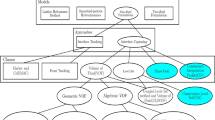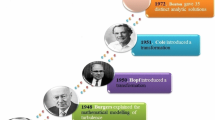Abstract
The SUPG/θ-method for applications in 2D advection–diffusion transport simulation is reviewed and it is presented in details. Spatial discretization is done with finite elements method with stabilized streamline upwind Petrov–Galerkin method, and time discretization was done with θ-stable finite difference operator. Numerical tests showed that this algorithm is general and robust and it can be applied to simulate simple problems of mass transport; for example, pure advection phenomenon in structured mesh, as well as reactive advection–diffusion transport with an unstructured mesh, and not well-behaved velocity field. The method was applied in a simulation of the transport of total phosphorus in the Lake Água Preta, and the results were validated by comparison with experimental data. The computational cost is directly associated with the value of the safety factor, introduced to assure the stability of the method.



















Similar content being viewed by others
Abbreviations
- \(\varvec{C}\) :
-
Damping matrix
- \(C\) :
-
Mass concentration, mg/L
- D :
-
Diffusion coefficient or diffusivity, m2/s
- h :
-
Local size mesh
- k :
-
Reaction coefficient
- \(\varvec{N}\) :
-
Basis function vector
- n :
-
Normal vector
- n :
-
Time step
- \(P\) :
-
Perturbation term to the weighting function
- s :
-
Safety factor
- S :
-
Source term
- t :
-
Time, s
- u :
-
Velocity vector, m/s
- \(w\) :
-
Weight function
- x :
-
Spatial vector, m
- \(\Upgamma\) :
-
Contour of the model
- \(\theta\) :
-
Method for time discretization
- \(\tau\) :
-
Stabilization parameter
- \({\varvec{\Upomega}}\) :
-
Domain of the model
References
Bochev PB, Gunzburger MD, Shadid JN (2004) Stability of the SUPG finite element method for transient advection-diffusion problems. Comput Methods Appl Mech Eng 193:2301–2323
Burman E (2010) Consistent SUPG-methods for transient transport problems: stability and convergence. Comput Methods Appl Mech Eng 199:1114–1123
Carnahan B, Luther HA, Wilkes JO (1969) Applied numerical methods. John Wiley & Sons Ltd, New York
Donea J, Huerta A (2003) Finite element methods for flow problems. John Wiley & Sons Ltd, England, p 362
Franca LP, Hauke G, Masud A (2006) Revisiting stabilized finite element methods for the advective-diffusive equation. Comput Methods Appl Mech Eng 195:1560–1572
Gockenbach MS (2006) Understanding and implementing the finite element method. Soc Ind Appl Math, Philadelphia, p 363
Griebel M, Dornseifer T, Neunhoeffer T (1998) Numerical simulation in fluid dynamics: a pratical introduction, society for industrial and applied mathematics. Philadelphia, p 234
Hervouet J-M (2007) Hydrodynamics of free surface flows: modelling with the finite element method. John Wiley & Sons Inc., Chichester, p 366
Holanda PS, Blanco CJC, Cruz DOA et al (2011) Hydrodynamic modeling and morphological analysis of lake Água Preta: one of the water sources of Belém-PA-Brazil. J Brazilian Soc Mech Sci Eng v. XXXIII1(2):117–124
Moreland K (2011) The paraview tutorial version 3.10. Sandia national laboratories. http://www.paraview.org/Wiki/images/2/2d/ParaViewTutorial310.pdf
Lewis WL, Nithiarasu P, Seetharamu KN (2004) Fundamentals of the finite element method for heat and fuid flow. John Wiley & Sons Ltd., England, p 356
Massabó M, Cianci R, Paladino O (2011) An analytical solution of the advection dispersion equation in a bounded domain and its application to laboratory experiments. J Appl Math 2011:1–14
Patankar SV (1980) Numerical heat transfer and fluid flow. Hemisphere, New York
Rubin H, Atkinson J (2001) Environmental fluid mechanics. Marcel Dekker Inc., New York, p 752
Saad Y, Schultz MH (1986) GMRES: a generalized minimal residual algorithm for solving nonsymmetric linear systems. Siam J Sci Stat Comput 7:856–869
Secretan Y, Leclerc M (1998) Modeleur: a 2D hydrodynamic GIS and simulation software. In: Hyroinformatics-98. Copenhagen, pp 1-18
Silva JP (2010) “Avaliação da qualidade da Água Superficial utilizada no sistema de abastecimento público do município de Belém (PA)”, Dissertação (Mestrado). ITEC/UFPA, Belém
Socolofsky SA, Jirka GH (2004) Special topics in mixing and transport process in the environment, Online material: https://ceprofs.civil.tamu.edu/ssocolofsky/cven489/Book/Book.htm
Solín P (2006) Partial differential equations and the finite element method. John Wiley & Sons Inc., New Jersey, p 499
Tezduyar T, Sathe S (2003) Stabilization parameters in SUPG and PSPG formulations. J Comput Appl Mech 4(1):71–88
Tezduyar T (1992) Stabilized finite element formulations for incompressible flow computations. Adv Appl Mech 28:1–44
Tezduyar T (2001) Adaptive determination of the finite element stabilization parameters. ECCOMAS computational fluid dynamics conference. Swansea, Wales, UK, 4–7 Sept 2001
Vasconcelos VMM, Souza CF (2011) Caracterização dos parâmetros de qualidade da água do manancial Utinga, Belém, PA, Brazil. Revista Ambiente e Água 6(2):305–324
Acknowledgments
The first author would like to thanks to FAPESPA for financial support.
Author information
Authors and Affiliations
Corresponding author
Additional information
Technical Editor: Francisco Cunha.
Rights and permissions
About this article
Cite this article
Lima, R.C., Mesquita, A.L.A., Blanco, C.J.C. et al. On the application of SUPG/θ-method in 2D advection–diffusion-reaction simulation. J Braz. Soc. Mech. Sci. Eng. 36, 591–603 (2014). https://doi.org/10.1007/s40430-013-0099-6
Received:
Accepted:
Published:
Issue Date:
DOI: https://doi.org/10.1007/s40430-013-0099-6




